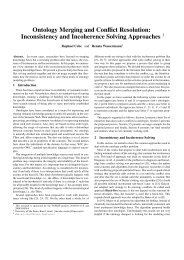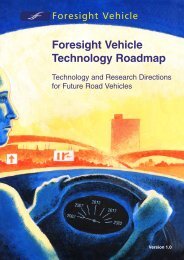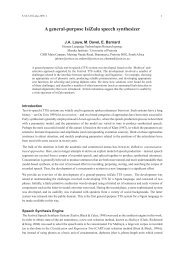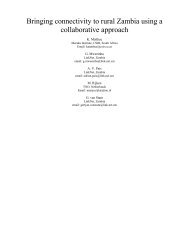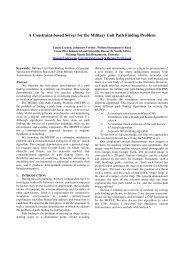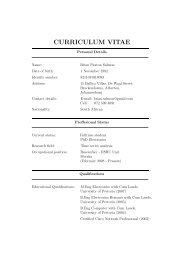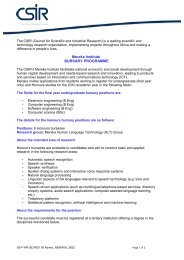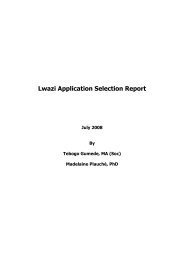Initial fieldwork for LWAZI: A telephone-based ... - Meraka Institute
Initial fieldwork for LWAZI: A telephone-based ... - Meraka Institute
Initial fieldwork for LWAZI: A telephone-based ... - Meraka Institute
You also want an ePaper? Increase the reach of your titles
YUMPU automatically turns print PDFs into web optimized ePapers that Google loves.
shadowed a CDW during a typical day and we<br />
toured the communities, including visiting farms,<br />
day-care centres, churches, markets, youth<br />
centres, clinics, businesses and households.<br />
The eleven communities we visited were<br />
located throughout eight of the nine provinces of<br />
South Africa. They varied greatly in available<br />
infrastructure and language spoken. They shared<br />
an economic dependency on nearby cities and, in<br />
some cases, reported social problems. These<br />
communities also share a dependency on<br />
government social grant. As mentioned above,<br />
because of high levels of unemployment, these<br />
community’s livelihoods is sustained by grants<br />
from government.<br />
Number of communities<br />
9<br />
8<br />
7<br />
6<br />
5<br />
4<br />
3<br />
2<br />
1<br />
0<br />
Primary problems in the 11 communities visited<br />
6<br />
Access to<br />
services such<br />
as health,<br />
social<br />
1<br />
Orphans<br />
8<br />
Unemployment<br />
Type of problem<br />
5<br />
Crime<br />
4<br />
Alcohol and<br />
drug abuse<br />
Figure 2: Number of the eleven communities that<br />
site these as primary problems in the community,<br />
as reported by interviewees.<br />
There are four mobile providers in South<br />
Africa namely Cell-C, MTN, Virgin Mobile and<br />
Vodacom. The two landline companies, Neo-tell<br />
and Telkom are not familiar in the communities<br />
visited by Lwazi team. Community members<br />
prefer and use mobile phones because of ease of<br />
use and accessibility. Figure 3 illustrates the use<br />
of mobile providers in the eleven visited<br />
communities.<br />
Number of communities<br />
12<br />
10<br />
8<br />
6<br />
4<br />
2<br />
0<br />
Mobile provider in communities visited<br />
Cell-C MTN Virgin Vodacom<br />
Mobile providers<br />
Figure 3: Mobile provider in communities visited<br />
Figure 4 below shows that all eleven<br />
communities visited received government<br />
in<strong>for</strong>mation through print. This, as mentioned<br />
earlier, is one of the problems the government is<br />
trying to address because of a high illiterate<br />
number. The second commonly used source of<br />
in<strong>for</strong>mation was the community development<br />
workers. This is a useful source because they are<br />
the ‘foot soldiers’ of the government; they are<br />
responsible <strong>for</strong> door to door visits, collecting and<br />
delivering in<strong>for</strong>mation. This source has its own<br />
challenges as discussed above.<br />
Number of communities<br />
12<br />
10<br />
8<br />
6<br />
4<br />
2<br />
0<br />
CDW<br />
Sources of government in<strong>for</strong>mation<br />
Public<br />
meetings<br />
local radio<br />
station in<br />
local language<br />
Sources of in<strong>for</strong>mation<br />
Print media<br />
Government<br />
print<br />
(including<br />
Vukuzenzele)<br />
Figure 4: sources of government in<strong>for</strong>mation<br />
4.1. In<strong>for</strong>mation Needs and Sources<br />
The majority of communities report a lack of<br />
economic activity as the primary problem in the<br />
community, and as could be expected, we<br />
observed very high levels of unemployment. .<br />
Grants are offered by the South African<br />
government to address the imbalance and<br />
4




